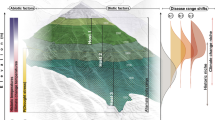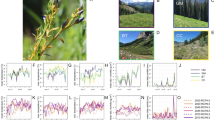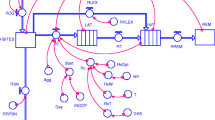Abstract
Context
Factors influencing the early stages of biological invasions, especially how the outbreak conditions project to later patterns of organism spread, is an important but rarely studied aspect of invasion biology.
Objectives
Our objectives were to determine whether a simple function relates outbreak disease levels and end epidemic magnitude for wheat stripe rust and to evaluate the potential role of propagule pressure.
Methods
We superimposed data from experimentally initiated wheat stripe rust outbreaks (disease levels ranging from 0.01 to 30 % of the wheat host) in central Oregon, USA on the function relating disease outbreak prevalence to end epidemic magnitude in the simulation program EPIMUL. We also used EPIMUL to assess an alternative hypothesis that wheat stripe rust spread is driven by outbreak area, not propagule number, by varying outbreak area and holding the outbreak disease levels constant.
Results
A simple power function related outbreak disease levels to end epidemic magnitude and expanse of spread for wheat stripe rust in simulations. When this function was superimposed on field data, there was a tolerable alignment. Simulations suggested that end epidemic magnitude and expanse of disease spread is influenced more by changes in outbreak disease levels than outbreak area.
Conclusions
The landscape spread of disease epidemics may be projected and reconstructed by the application of a simple power function with outbreak disease levels. Moreover, this relationship may be a useful starting point for projecting and reconstructing the patterns of biological invasions for r-selected species with long-distance dispersal.




Similar content being viewed by others
References
Alonso D, McKane AJ, Pascual M (2007) Stochasitic amplification in epidemics. J R Soc Lond Interface 4:575–582
Balcan D, Colizza V, Gonçalves B, Hu H, Ramasco JJ, Vespignani A (2009) Multiscale mobility networks and the spatial spreading of disease. Proc Natl Acad Sci 106:21484–21489
Britton JR, Gozlan RE (2013) How many founders for a biological invasion? Predicting introduction outcomes from propagule pressure. Ecology 94:2558–2564
Burdon JJ, Thrall PH (2014) What have we learned from studies of wild-pathogen associations?—the dynamic interplay of time, space and life-history. Eur J Plant Pathol 138:417–439
Chen XM (2005) Epidemiology and control of stripe rust on wheat. Can J Plant Pathol 27:314–337
Chen XM, Moore M, Milus EA, Long DL, Line RF, Marshall D, Jackson L (2002) Wheat stripe rust epidemics and races of Puccinia striiformis f. sp. tritici in the United States in 2000. Plant Dis 86:39–46
Clobert J, Baguette M, Benton TG, Bullock JM (eds) (2012) Dispersal ecology and evolution. Oxford University Press, Oxford
Cowger C, Wallace LD, Mundt CC (2005) Velocity of spread of wheat stripe rust epidemics. Phytopathology 95:972–982
Dybiec B, Kleczkowski A, Gilligan CA (2009) Modelling control of epidemics spreading by long-range interactions. J R Soc Interface 6:941–950
Estep LK, Sackett KE, Mundt CC (2014) Influential disease foci in epidemic expansion and their underlying mechanisms: simulations and a field experiment with a plant pathogen. Ecol Appl. doi:10.1890/13-1408.1
Eubank S, Guclu H, Anil Kumar VS, Marathe MV, Srinivasan A, Toroczkai Z, Wang N (2004) Modelling disease outbreaks in realistic urban social networks. Nature 429:180–184
Facon B, Genton BJ, Shykoff J, Jarne P, Estoup A, David P (2006) A general eco-evolutionary framework for understanding bioinvasions. Trends Ecol Evol 21:130–135
Ferrandino FJ (1993) Dispersive epidemic waves: I. Focus expansion within a linear planting. Phytopathology 83:795–802
Filipe JAN, Cobb RC, Meentemeyer RK, Lee CA, Valachovic YS, Cook AR, Rizzo DM, Gilligan CA (2012) Landscape epidemiology and control of pathogens with cryptic and long-distance dispersal: sudden oak death in northern californian forests. PLoS Comput Biol 8(1):e1002328
Forrest BM, Fletcher LM, Atalah J, Piola RF, Hopkins GA (2013) Predation limits spread of Didemnum vexillum into natural habitats from refuges on anthropogenic structures. PLoS One 8(12):e82229
Gilligan CA, van den Bosch F (2008) Epidemiological models for invasion and persistence of pathogens. Ann Rev Phytopathol 46:385–418
Gisiger T (2001) Scale invariance in biology: coincidence or footprint of a universal mechanism? Biol Rev 76:161–209
Grevstad FS (1999) Factors influencing the chance of population establishment: implications for release strategies in biocontrol. Ecol Appl 9:1439–1447
Hastings A, Cuddington K, Davies KF, Dugaw CJ, Elmendorf S, Freestone A, Harrison S, Holland M, Lambrinos J, Malvadkar U, Melbourne BA, Moore K, Taylor C, Thomson D (2005) The spatial spread of invasions: new developments in theory and evidence. Ecol Lett 8:91–101
Hawley DM, Osnas EE, Dobson AP, Hochachka WM, Ley DH, Dhont AA (2013) Parallel patterns of increased virulence in a recently emerged wildlife pathogen. PLoS Biol 11(5):e1001570
Hess GR (1994) Conservation corridors and contagious disease: a cautionary note. Conserv Biol 8:256–262
Holway DA (1998) Factors governing rate of invasion: a natural experiment using argentine ants. Oecologia 115:206–212
Hulme PE (2003) Biological invasions: winning the science battles but losing the conservation war? Oryx 37:178–193
Jombart T, Corri A, Didelot X, Cauchemez S, Fraser C, Ferguson N (2014) Bayesian reconstruction of disease outbreaks by combining epidemiologic and genomic data. PLoS Comput Biol 10:e1003457
Jones KE, Patel NG, Levy MA, Storeygard A, Balk D, Gittleman JL, Daszak P (2008) Global trends in emerging infectious diseases. Nature 451:990–993
Keeling MJ, Woolhouse MEJ, Shaw DJ, Matthews L, Chase-Topping M, Haydon DT, Cornell SJ, Kappey J, Wilesmith J, Grenfell BJ (2001) Dynamics of the 2001 UK foot and mouth epidemic: stochastic dispersal in a heterogeneous landscape. Science 294:813–817
Laine AL, Burdon JJ, Dodds PN, Thrall PH (2011) Spatial variation in disease resistance: from molecules to populations. J Ecol 99:96–112
Lannou C (2012) Variation and selection of quantitative traits in plant pathogens. Ann Rev Phytopathol 50:319–338
Levine JM (2000) Species diversity and biological invasions: relating local process to community pattern. Science 288:852–854
Lindström T, Håkansson N, Wennergren U (2011) The shape of the spatial kernel and its implications for biological invasions in patchy environments. Proc R Soc Lond B 278:1564–1571
Madden LV, Hughes G, van den Bosch F (2007) The study of plant disease epidemics. APS Press, St. Paul
Melbourne BA, Hastings A (2009) Highly variable spread rates in replicated biological invasions: fundamental limits to predictability. Science 325:1536–1539
Meentemeyer RK, Haas SE, Václavìk T (2012) Landscape epidemiology of emerging infectious diseases in natural and human altered ecosystems. Ann Rev Phytopathol 50:379–402
Meyers JH, Bazely DR (2003) Ecology and control of introduced plants. Cambridge University Press, Cambridge
Miller TEX, Inouye BD (2013) Sex and stochasticity affect range expansion of experimental invasions. Ecol Lett 16:354–361
Milus EA, Kristensen K, Hovmøller MS (2009) Evidence for increased aggressiveness in a recent widespread strain of Puccinia striiformis f. sp. tritici causing stripe rust of wheat. Phytopathology 99:89–94
Mundt CC, Sackett KE, Wallace LD, Cowger C, Dudley JP (2009) Long-distance dispersal and accelerating waves of disease: empirical relationships. Am Nat 173:456–466
Mundt CC, Sackett KE (2012) Spatial scaling relationships for spread of disease caused by a wind-dispersed plant pathogen. Ecosphere 3:art24
Mundt CC, Wallace LD, Allen TW, Hollier CA, Kamerait RC, Sikora EJ (2013) Initial epidemic area is strongly associated with the yearly extent of soybean rust spread in North America. Biol Invasions 15:1431–1438
Newman MEJ (2002) Spread of epidemic disease on networks. Phys Rev E 66:016128
Ostfeld RS, Glass GE, Keesing F (2005) Spatial epidemiology: an emerging (or re-emerging) discipline. Trends Ecol Evol 20:328–336
Pybus OG, Suchard MA, Lemey P, Bernardin FJ, Rambaut A, Crawford FW, Gray RR, Arinaminpathy N, Stramer SL, Busch MP, Delwart EL (2012) Unifying the spatial epidemiology and molecular evolution of emerging epidemics. Proc Natl Acad Sci 109:15066–15071
Reynolds AM, Bohan DA, Bell JR (2007) Ballooning dispersal in arthropod taxa: conditions at take-off. Biol Lett 3:237–240
Sackett KE, Mundt CC (2005a) Primary disease gradients of wheat stripe rust in large field plots. Phytopathology 95:983–991
Sackett KE, Mundt CC (2005b) The effects of dispersal gradient and pathogen life cycle components on epidemic velocity in computer simulations. Phytopathology 95:992–1000
Sakai AK, Allendorf FW, Holt JS, Lodge DM, Molofsky J, With KA, Baughman S, Cabin RJ, Cohen JE, Ellstrand NC, McCauley DE, O’Neil P, Parker IM, Thompson JM, Weller SG (2001) The population biology of invasive species. Annu Rev Ecol Syst 32:305–332
Severns PM, Estep LK, Sackett KE, Mundt CC (2014) Degree of host susceptibility in the initial disease outbreak influences subsequent epidemic spread. J Appl Ecol. doi:10.1111/1365-2664.12326
Shaner G, Powelson RL (1971) Epidemiology of stripe rust of wheat, 1961–1968. Or Agric Exp Stn Bull 117:1–36
Simberloff D (2009) The role of propagule pressure in biological invasions. Annu Rev Ecol Evol Syst 40:81–102
Thrall PH, Burdon JJ (2003) Evolution of virulence in plant host–pathogen metapopulation. Science 299:1735–1737
Urban MC, Phillips BL, Skelly DK, Shine R (2008) A toad more traveled: the heterogeneous invasion dynamics of cane toads in Australia. Am Nat 171:E134–E148
Van de Water PK, Watrud LS, Lee EH, Burdick C, King GA (2007) Long-distance GM pollen movement of creeping bentgrass using modeled wind trajectory analysis. Ecol Appl 17:1244–1256
Von Holle B, Simberloff D (2005) Ecological resistance to biological invasion overwhelmed by propagule pressure. Ecology 86:3212–3218
Wan A, Zhao Z, Chen X, He Z, Jin S, Jia Q, Yao G, Yang J, Wang B, Li G, Bi Y, Yuan Z (2004) Wheat stripe rust epidemic and virulence of Puccinia striiformis f. sp. tritici in China in 2002. Plant Dis 88:896–904
Wellings CR (2007) Puccinia stiiformis in Australia: a review of the incursion, evolution and adaptation of stripe rust in the period 1979–2006. Aust J Agric Res 58:567–575
Wellings CR (2011) Global status of stripe rust: a review of historical and current threats. Euphytica 179:129–141
With KA (2002) The landscape ecology of invasive spread. Conserv Biol 16:1192–1203
Wittman MJ, Metzler D, Gabriel W, Jeschke JM (2014) Decomposing propagule pressure: the effects of propagule size and propagule frequency on invasion success. Oikos 123:441–450
Xu XM, Ridout MS (1998) Effects of initial epidemic conditions, sporulation rate, and spore dispersal gradient on the spatio-temporal dynamics of plant disease epidemics. Phytopathology 88:1000–1012
Zadoks JC, Kampmeijer P (1977) The role of crop populations and their deployment, illustrated by means of a simulator, EPIMUL76. Ann N Y Acad Sci 287:164–190
Zadocks JC, van den Bosch F (1994) On the spread of plant disease: a theory on foci. Ann Rev Phytopathol 32:503–521
Acknowledgments
This research was supported by the National Institute of Health # R01GM96685 Ecology and Evolution of Infectious Diseases Program. We thank three anonymous reviewers and K. Moloney for providing comments that helped improve this manuscript.
Author information
Authors and Affiliations
Corresponding author
Electronic supplementary material
Below is the link to the electronic supplementary material.
Rights and permissions
About this article
Cite this article
Severns, P.M., Sackett, K.E. & Mundt, C.C. Outbreak propagule pressure influences the landscape spread of a wind-dispersed, epidemic-causing, plant pathogen. Landscape Ecol 30, 2111–2119 (2015). https://doi.org/10.1007/s10980-015-0234-0
Received:
Accepted:
Published:
Issue Date:
DOI: https://doi.org/10.1007/s10980-015-0234-0




